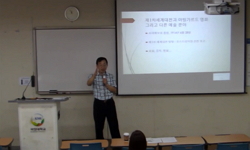In coastal residential communities, especially along the coastline, flooding is a frequent natural hazard that impacts the area. To reduce the adverse effects of flooding, it is recommended to elevate coastal buildings to a certain safe level. However...
http://chineseinput.net/에서 pinyin(병음)방식으로 중국어를 변환할 수 있습니다.
변환된 중국어를 복사하여 사용하시면 됩니다.
- 中文 을 입력하시려면 zhongwen을 입력하시고 space를누르시면됩니다.
- 北京 을 입력하시려면 beijing을 입력하시고 space를 누르시면 됩니다.
https://www.riss.kr/link?id=A107097345
-
저자
Nourhan Abdelfatah (Florida International University) ; Amal Elawady (Florida International University) ; Peter Irwin (Florida International University) ; Arindam Chowdhury (Florida International University)
- 발행기관
- 학술지명
- 권호사항
-
발행연도
2020
-
작성언어
English
- 주제어
-
등재정보
KCI등재,SCIE,SCOPUS
-
자료형태
학술저널
-
수록면
335-350(16쪽)
-
KCI 피인용횟수
0
- 제공처
-
0
상세조회 -
0
다운로드
부가정보
다국어 초록 (Multilingual Abstract)
In coastal residential communities, especially along the coastline, flooding is a frequent natural hazard that impacts the area. To reduce the adverse effects of flooding, it is recommended to elevate coastal buildings to a certain safe level. However, post storm damage assessment has revealed severe damages sustained by elevated buildings’ components such as roofs, walls, and floors. By elevating a structure and creating air gap underneath the floor, the wind velocity increases and the aerodynamics change. This results in varying wind loading and pressure distribution that are different from their slab on grade counterparts. To fill the current knowledge gap, a large-scale aerodynamic wind testing was conducted at the Wall of Wind experimental facility to evaluate the wind pressure distribution over the surfaces of a low-rise gable roof single-story elevated house. The study considered three different stilt heights. This paper presents the observed changes in local and area averaged peak pressure coefficients for the building surfaces of the studied cases. The aerodynamics of the elevated structures are explained. Comparisons are done with ASCE 7-16 and AS/NZS 1170.2 wind loading standards. For the floor surface, the study suggests a wind pressure zoning and pressure coefficients for each stilt height.
참고문헌 (Reference)
1 Mahendran, M., "Wind-resistant low-rise buildings in the tropics" 9 : 330-346, 1995
2 Choi, C. K., "Wind tunnel blockage effects on aerodynamic behavior of bluff body" 1 (1): 351-364, 1998
3 Holmes, J. D., "Wind pressures on tropical housing" 53 : 105-123, 1994
4 Cochran, L., "Wind issues in the Design of Buildings" American Society of Civil Engineers 2012
5 Ahmed Elshaer, "Variation in wind load and flow of a low-rise building during progressive damage scenario" 한국풍공학회 28 (28): 389-404, 2019
6 FEMA, "Summary Report on Building Performance"
7 Australian/New Zealand Standard, "Structural Design Actions, Part 2: Wind actions"
8 Gross, R., "Stilt houses: 10 reasons to get your house off the ground"
9 FEMA, "Recommended Residential Construction for Coastal Areas: Building on Strong and Safe Foundations"
10 Cheung, J. C. K., "Pressures on a 1/10 scale model of the Texas Tech Building" 71 : 529-538, 1997
1 Mahendran, M., "Wind-resistant low-rise buildings in the tropics" 9 : 330-346, 1995
2 Choi, C. K., "Wind tunnel blockage effects on aerodynamic behavior of bluff body" 1 (1): 351-364, 1998
3 Holmes, J. D., "Wind pressures on tropical housing" 53 : 105-123, 1994
4 Cochran, L., "Wind issues in the Design of Buildings" American Society of Civil Engineers 2012
5 Ahmed Elshaer, "Variation in wind load and flow of a low-rise building during progressive damage scenario" 한국풍공학회 28 (28): 389-404, 2019
6 FEMA, "Summary Report on Building Performance"
7 Australian/New Zealand Standard, "Structural Design Actions, Part 2: Wind actions"
8 Gross, R., "Stilt houses: 10 reasons to get your house off the ground"
9 FEMA, "Recommended Residential Construction for Coastal Areas: Building on Strong and Safe Foundations"
10 Cheung, J. C. K., "Pressures on a 1/10 scale model of the Texas Tech Building" 71 : 529-538, 1997
11 Goliber, M.R., "Pressure distribution on the roof of a model low- rise building tested in a boundary layer wind tunnel" 2009
12 Mooneghi, M. A., "Partial turbulence simulation method for predicting peak wind loads on small structures and building appurtenances" 157 : 47-62, 2016
13 Hamzeh Gol-Zaroudi, "Open-jet boundary-layer processes for aerodynamic testing of low-rise buildings" 한국풍공학회 25 (25): 233-259, 2017
14 Hoxey, R. P., "Observations of Reynolds number sensitivity in the separated flow region on a bluff body" 73 : 231-249, 1998
15 The National Science Foundation, "Network, and Structural Extreme Events Reconnaissance (StEER) (2019)"
16 Cangialosi, J. P., "National Hurricane Center Tropical Cyclone Report: Huricane Irma" Natl. Huricane Cent 1-111, 2018
17 Pasch, R.J., "National Hurricane Center Tropical Cyclone Report, Hurricane Maria, 16-30"
18 Blake, E.S., "National Hurricane Center Tropical Cyclone Report, Hurricane Harvey 1-77"
19 Jing He, "Modeling wind load paths and sharing in a wood-frame building" 한국풍공학회 29 (29): 177-194, 2019
20 American Society of Civil Engineering, "Minimum Design Loads for Buildings and Other Structures (ASCE/SEI 7-10)"
21 American Society of Civil Engineering, "Minimum Design Loads and Associated Criteria for Buildings and Other Structures (ASCE/SEI 7-16)"
22 Chowdhury, A. G., "Large-scale experimentation using the 12-fan wall of wind to assess and mitigate hurricane wind and rain impacts on buildings and infrastructure systems" 143 : 04017053-, 2017
23 Moravej, M., "Investigating scale effects on analytical methods of predicting peak wind loads on buildings" FIU 2018
24 National Science Board, "Hurricane warning: The critical need for a national hurricane research initiative" National Science Foundation 2007
25 Artemis, "Hurricane Michael wind & surge insured loss up to $ 4.5bn" Arteis
26 Willis, Re, "Hurricane Michael damage survey report" United States Environmental Protection Agency 2018
27 Alipour, A., "Hurricane Michael Preliminary Virtual Assessment Team (p-vat) Report" 2018
28 Cochran, L. S., "Full- and model-scale cladding pressures on the Texas Tech University experimental building" 43 : 1589-1600, 1992
29 Holmes, J.D., "Flow behind two-dimensional barriers on a Roughened ground plane, and applications for atmospheric boundary layer modelling" 28 : 1983
30 Kreibich, H., "Flood loss reduction of private households due to building precautionary measures – lessons learned from the Elbe flood in August 2002" 5 : 117-126, 2005
31 Bin, O., "Flood hazards, insurance rates, and amenities: Evidence from the coastal housing market" 75 : 63-82, 2008
32 Moravej, M., "Effects of roof height on local pressure and velocity coefficients on building roofs" 150 : 693-710, 2017
33 Beste, F., "Correlation of internal and area-averaged external wind pressures on low-rise buildings" 69-71 : 557-566, 1997
34 R.P. Hoxey, "Correction of wind-tunnel pressure coefficients for Reynolds number effect" Elsevier BV 69-71 : 547-555, 1997
35 Irwin, H.P.A.H., "Correction of distortion effects caused by tubing systems in measurements of fluctuating pressures" 5 : 93-107, 1979
36 English, E.C., "Combined flood and wind mitigation for hurricane damage prevention: Case for amphibious construction" 143 : 06017001-, 2017
37 Tomiczek, T., "Collapse limit state fragilities of wood-framed residences from storm surge and waves during hurricane Ike" 140 : 43-55, 2014
38 Engineering Sciences Data Unit, "Characteristics of atmospheric turbulence near the ground Part III : variations in space and time for strong winds"
39 Jing He, "Assessment of ASCE 7-10 for wind effects on low-rise wood frame buildings with database-assisted design methodology" 한국풍공학회 27 (27): 163-173, 2018
40 English, E., "Amphibious construction vs. permanent static elevation: flood resilience without increased vulnerability to wind" 2015
41 Zachry, B. C., "A national view of storm surge risk and inundation" 7 : 109-117, 2015
42 X.X. Cheng, "A comprehensive high Reynolds number effects simulation method for wind pressures on cooling tower models" 한국풍공학회 24 (24): 119-144, 2017
동일학술지(권/호) 다른 논문
-
- 한국풍공학회
- Ramazan Özkan
- 2020
- KCI등재,SCIE,SCOPUS
-
Airflow over low-sloped gable roof buildings: Wind tunnel experiment and CFD simulations
- 한국풍공학회
- Ruizhou Cao
- 2020
- KCI등재,SCIE,SCOPUS
-
Comparison of tropical cyclone wind field models and their influence on estimated wind hazard
- 한국풍공학회
- J.Y. Gu
- 2020
- KCI등재,SCIE,SCOPUS
-
Investigation of surface pressures on CAARC tall building concerning effects of turbulence
- 한국풍공학회
- Yong-gui Li
- 2020
- KCI등재,SCIE,SCOPUS
분석정보
인용정보 인용지수 설명보기
학술지 이력
| 연월일 | 이력구분 | 이력상세 | 등재구분 |
|---|---|---|---|
| 2022 | 평가예정 | 해외DB학술지평가 신청대상 (해외등재 학술지 평가) | |
| 2021-12-01 | 평가 | 등재후보 탈락 (해외등재 학술지 평가) | |
| 2020-12-01 | 평가 | 등재후보로 하락 (해외등재 학술지 평가) |  |
| 2011-01-01 | 평가 | 등재학술지 유지 (등재유지) |  |
| 2009-01-01 | 평가 | 등재학술지 유지 (등재유지) |  |
| 2007-01-01 | 평가 | 등재 1차 FAIL (등재유지) |  |
| 2005-09-23 | 학술지등록 | 한글명 : Wind and Structures, An International Journal외국어명 : Wind and Structures, An International Journal |  |
| 2004-01-01 | 평가 | 등재학술지 선정 (등재후보2차) |  |
| 2003-01-01 | 평가 | 등재후보 1차 PASS (등재후보1차) |  |
| 2001-07-01 | 평가 | 등재후보학술지 선정 (신규평가) |  |
학술지 인용정보
| 기준연도 | WOS-KCI 통합IF(2년) | KCIF(2년) | KCIF(3년) |
|---|---|---|---|
| 2016 | 0.9 | 0.45 | 0.69 |
| KCIF(4년) | KCIF(5년) | 중심성지수(3년) | 즉시성지수 |
| 0.62 | 0.58 | 0.301 | 0.15 |






 KCI
KCI






